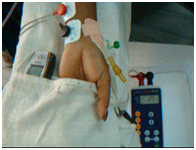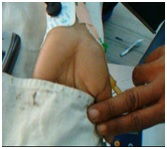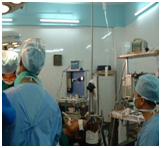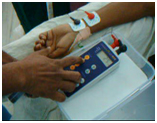Rocuronium is a NDMR drug, which has rapid onset and intermediate duration of action. 2xED95 doses (0.6mg/kg) of rocuronium are frequently used for intubations at 60 seconds [1–6]. Some studies have shown that 3XED95 dose provides excellent intubating conditions at 60 seconds [7–9]. Some studies compared and concluded 3ED95 dose of Rocuronium provides better intubating conditions at 60 seconds than of 2xED95 [8–13].
In this context, our study aimed at comparing intubating conditions with 2xED95 (0.6 mg/kg) and 3xED95 (0.9mg/kg)dose of rocuronium, using clinical criteria with cooper’s score [1]; assisted with T.O.F response of adductor pollicis muscle (AP) to ulnar nerve stimulation.
Materials and Methods
After obtaining permission from hospital ethical committee and informed, written consent of patients, this prospective, randomized comparative clinical study was conducted on 60 patients with ASA grade I&II, and MPS class I&II of either sex within the age group of 18-60 years-scheduled for different elective surgical procedures under planned general anaesthesia over 1year.
Exclusions:-
Patients with ASA III and IV,
Patients with drug allergy,
Patients with anticipated difficult air way,
Patients with neuromuscular disorders,
Patients who failed to be intubated at 60 seconds,
Patients< 18 years of age.
The patients were randomly allocated into two equal groups containing 30 patients in each.
Group-A: Patients receiving 2xED95 dose of Rocuronium as an initial bolus dose.
Group B: Patients receiving 3xED95 dose of Rocuronium as an initial bolus dose.
After premeditation with Fentanyl (1μg/kg), Glycopyrrolate 0.2 mg and ondensatron 4mg, induction was done with propofol (2mg/kg). After fixing the electrodes near the wrist, assessment [Table/Fig-1] of adductor pollicis response for 1 Hz single twitch stimulation of ulnar nerve was carried out starting from the minimum intensity of current, intensity of supra maximal stimulus was fixed as 20-25% more than the current strength required to produce a max single twitch response.
Eliciting twitch response in AP

AP-TOF responses were elicited by stimulating ulnar nerve with 0.5 HZ stimuli of supra maximal current strength and assessed by visual and tactile means. First TOF response reading was taken after induction (control). Second TOF reading was taken immediately after the injection of rocuronium (0 sec. reading). Third reading at 60 sec, at the time of intubation [Table/Fig-1,2 and 3].
AP-TOF response assessment by tectile means

Patient intubated at 60 Seconds

The onset of fade can be detected by sequential disappearances of responses to TOF stimuli. TOF response is a most convenient pattern in determining the onset and intensification of the neuromuscular block produced by a NDMR drug. As NDMR-relaxant effect starts to manifest; 4th TOF response at AP disappears approximately at 75% [14–21,22] block 3rd at 80%, 2nd at 90% & 1st response disappears when there will be a complete block [14–21,22] [Table/Fig-4].
Correlation of sequential disappearance of twitch response within tensification of NMB
| Disappearance of Twitch (Fade) in AP | %NMB | TOF Count | Assessment of intubating conditions by TOF counts |
|---|
| 4th | 75% | 3 | Poor |
| 3rd | 80% | 2 | Fair |
| 2nd | 90% | 1 | Good |
| 1st | 100% | 0 | Excellent (Complete NMB) |
This provides information on an optimal time for a smooth intubation. Visual/tactile means of assessment of AP -TOF response to ulnar nerve stimulation is quite accurate [14–19,22]. Adequate relaxation for intubation is obtained when TOF responses are 2 or 1 when NMB is 80% [16–18]. TOF count measured by visual and tactile means is quite accurate [16].
Based on the pattern of sequential disappearance TOF twitches (fade of TOF response in AP), the intubating conditions were classified as excellent (count 0), good (count 1), fair (count 2) and poor (count 3,4).
Intubation was fixed to be done at 60 seconds after the administration of initial bolus dose of rocuronium. Two teams of anaesthesiologists were involved in the procedure. While one examined TOF responses; at the same time, the other did laryngoscopy and intubation.
Intubating conditions were assessed clinically and scored as excellent (8-9), good (6-7), fair (3-5) or poor (0-2) as per the scoring method described by Cooper et al., [1] [Table/Fig-5].
Cooper scoring system [1]
| Score | Jaw relaxation | Vocal cords | Response to intubation |
|---|
| 0 | Impossible | Closed | Severe coughing or Bucking |
| 1 | Opens | Closing | Mild coughing |
| 2 | Moderate | Moving | Slight diaphragmaticmovement |
| 3 | Easy | Open | No movement |
Based on the findings of TOF responses of AP (as TOF counts) for ulnar nerve stimulation, intubating conditions were also assessed as excellent, good, fair and poor as discussed earlier.
Subsequent TOF readings were taken at convenient repeated intervals till TOF response became 0 and thereafter, using a timer.
After intubation maintenance of anaesthesia was done by IPPV delivering N2O:O2=4:2. Subsequent doses of relaxant were injected as 1/3 of the initial dose as and when required.
Pulse rate, blood pressure, ECG, SPO2, ETCO2 were monitored and recorded at regular intervals. All patients were observed for side effects or drug reaction. Reversal was done with Myopyrrolate after assessing and confirming the adequate recovery by clinical criteria and by nerve stimulator.
Patients were shifted from operation theatre and were followed up in postoperative ward with emphasis on side effects of drug and nerve stimulation for 48 hours and recorded.
In our study, we used a battery operated peripheral nerve stimulator [Table/Fig-6] the innorvator-NS252 marketed by Fisher & Paykel health care.
Fisher & Paykel Peripheral Nerve stimulator

Stastical Analysis
Quantitative data were compared using unpaired t-test, and qualitative data were analyzed using chi-square test. Intubating conditions were compared using chi-square test. p >0.05, p<0.05 and p<0.001 were considered statistically insignificant, significant and highly significant respectively.
Statistical software
The Statistical software-Graph Pad In stat by graph pad software (INC., 5755. Oberlin drive# 110, San Diego CA 92121 USA) email: www.graphpad.com
SPSS 15.0, MedCalc 9.0.1 and Systat 11.0
Used for the analysis of the data and Microsoft word and Excel have been used to generate graphs, tables etc.
Observations and Results
A] Demographic profiles
Profiles were similar in both A and B study groups, and shown below [Table/Fig-7].
Demographic data of patients under study in different groups (p>0.05)
| Profiles | Group-A (Roc-0.6 mg/kg) | Group-B (Roc-0.9 mg/kg) |
|---|
| No of Patients | 30 | 30 |
| Mean age(Years) | 44.17 ± 11.72 | 43.17 ± 11.09 (p=0.5410 Paired T-Test) |
| Mean Wt(Kg) | 49.23 ± 9.35 | 49.37± 8.48 (p=0.5271 Paired t-test) |
| No. of Males | 21 | 18 {p=0.5 (Paired t Test)} |
| No. of Females | 9 | 12 p=0.5 (paired T-Test) |
| MPS 1 | 24 | 25 (p=0.1956 Chi square test) |
| MPS 2 | 6 | 5 (p=0.1956 Chi square test) |
| ASA1 | 26 | 25 (p=1.000 by fisher’s exact test) |
| ASA2 | 4 | 5 (p=1.000 by fisher’s exact test) |
| Surgeries performed:- (p=0.6637(chi-square test) |
| Abdominal surgeries | 13 | 10 |
| ENT and Head and Neck surgeries | 9 | 12 |
| Obg & pelvic surgeries | 8 | 8 |
| Mean intensity of supra max. stimuli (Ma) Paired t-test p=0.5219) |
| supra max. stimuli (mA) | 28.1666 | 28.666 |
There was no statistical significance between mean (±SD) in age, sex, weight male: female ratio and types of surgeries performed, intensity of current used among both the groups (p>0.05).
B] Conditions of intubation at 60 Seconds
1] Clinical assessment by cooper’s method: The Intubating conditions at 60 seconds as assessed clinically were excellent (score 8-9) in16 cases (53%), good (score 6-7) in 12 cases (40%), and fair (score 3-5) in 2 cases (7%) in Group-A, whereas in group-B excellent in 29 cases (97%)and good in 1case (3%) respectively. [Table/Fig-8,9,10 and 11](coopers’ scoring [1]).
| Impossible to Open (Score 0) | Opens with difficulty (score 1) | Moderate opening (score 2) | Easy opening (Score 3) |
|---|
| Group A No of cases | 0 | 0 | 6 (TOF 2,3 seen in 2 and 4 cases) | 24 (TOF 1,2,3,4 achieved in 1,5,12,6 cases) |
| Group B No of cases | 0 | 0 | 0 | 30 (TOF 0,1,2,3 in 18,4,7,1 cases) |
p=0.0237 (Fisher’s exact test)
Conditions of vocal cords
The two side p=0.0002 Considered extreemly significant (fisher’s exact test)
| Closed cords (Score 0) | Closing cords (score 1) | Moving cords (score 2) | Open cords (score 3) |
|---|
| Group A | 0 | 0 | 22 (TOF 2,3,4 seen in 3,13,6 cases) | 08 (TOF I,2,3 seen in 1,4,3 cases) |
| Group B | 0 | 0 | 1 (with TOF 2) | 29(TOF 0, I,2,3 seen in 18,4,6,1 cases) |
| Group-A | Group-B |
|---|
| Severe coughing/bucking (score 0) | 0 | 0 |
| Mild coughing (score-1) | 2 (TOF-3) | 0 |
| Slight diaphragmatic movements (score-2) | 22 (TOF 2,3,4 seen in 3,13,6 cases) | 11(TOF 0,1,2 seen in 6,1,4 cases) |
| No movement (score-3) | 6 (TOF I,2,3 seen in 1,4,1 cases | 19 (TOF 0, I,2,3 seen in 12,3,3,1 cases |
(p=0.0020 Chi square test)
| Study Groups | 9 | 8 | 7 | 6 | 5 | 4 | 3 | 2 | 1 | 0 | Total |
| Group-A | 4 | 12 | 10 | 2 | 2 | 0 | 0 | 0 | 0 | 0 | 30 |
| Group-B | 19 | 10 | 1 | 0 | 0 | 0 | 0 | 0 | 0 | 0 | 30 |
Excellent=8-9, Good=6-7, Fair=3-5, Poor= 0-2
Group Comparison was done with respect to excellent and good intubating conditions achieved by chi-square test. (p=0.0002) which confirmed that the observed difference in between group A (0.6 mg/kg Rocuronium) and Group B (0.9 mg/kg Rocuronium group) is statistically significant (p<0.0002).
2] Assessment of intubating conditions by TOF response in AP for ulnar nerve stimulation: In Group A in no case TOF 0 was achieved. TOF 1, 2,3, and 4 were observed in 1 case (3%), 7 cases (23%) 16 cases (54%) and 6 cases (20%) cases respectively.
Whereas in group B, TOF 0, 1, 2, 3 were observed in 18 cases (61%), 4 cases (13%), 7 cases (23%) and 1 case (3%) respectively and in no case TOF-4 was observed [Table/Fig-12]. Chi-square test (p<0.0001) confirmed the statistically highly significant difference existing in between the two groups with respect to elicited TOF counts, and also with respect to assessed intubating conditions. [Table/Fig-13]
Intubating conditions as assessed by TOF Response in AP
| TOF COUNTS | GROUP A | GROUP B | |
|---|
| 0 | 0 | 18 | Excellent |
| 1 | 1 | 4 | Good |
| 2 | 7 | 7 | Fair |
| 3 | 16 | 1 | Poor |
| 4 | 6 | 0 | Poor |
| TOTAL | 30 | 30 | 30 |
Chi square test p-value p=0.0312
| Intubating conditions as assessed by TOF response | Clinically assessed intubating conditions at 60 sec by Cooper’s scoring |
|---|
| Excellent | Good | Fair | Poor |
|---|
| Gr-A | Gr-B | Gr-A | Gr-B | Gr-A | Gr-B | Gr-A | Gr-B |
|---|
| TOF0 (excellent) | 0 | 18 | 0 | 0 | 0 | 0 | 0 | 0 |
| TOF-1 (good) | 1 | 4 | 0 | 0 | 0 | 0 | 0 | 0 |
| TOF-2 (fair) | 6 | 6 | 1 | 1 | 0 | 0 | 0 | 0 |
| TOF-3 (poor) | 7 | 1 | 7 | 0 | 2 | 0 | 0 | 0 |
| TOF-4 (poor) | 2 | 0 | 4 | 0 | 0 | 0 | 0 | 0 |
| Total no of cases | 16 | 29 | 12 | 1 | 2 | 0 | 0 | 0 |
C] Correlation of clinically assessed intubating conditions with those assessed By TOF response: Observed TOF response 0 was achieved in none in Group A, whereas in group B 18 cases achieved TOF 0 response. All these cases achieved excellent clinically assessed intubating conditions. TOF response 1 was achieved in 1 case in group A, and 4 cases in group-B. Though intubating conditions by TOF were assessed as good, by clinical assessment conditions were still excellent in cases with TOF-1. TOF response 2 (which indicates fair conditions) was achieved in 7 cases in group-A, and 7 cases in Group-B. Clinically assessed intubating conditions [with TOF-2] were excellent in 6 cases in both groups (12 cases), and good in one case in both groups (2 cases)
TOF response3- which indicates poor conditions was observed in 16 cases in group A, and only in one case in Group-B this indicates deeper NMB in Group B population. Clinically assessed intubating conditions [with TOF 3] were excellent in 7 cases (group-A), in one case (Group-B). Good and fair conditions were observed in 7 cases and 2 cases in Group-A.
TOF 4, which tells NMB<75% and indicates poor condition for intubation was observed in 6 cases (group-A); none in Group-B indicating deeper NMB in Group B population. Clinically assessed intubating conditions [with TOF-4] were Excellent in 2 cases, and good in 4 (Group-A)
Discussion
The extent of neuromuscular block [NMB] and recovery from it can be assessed clinically and by using a nerve stimulator [15–22]. Since adductor pollicis (AP) relaxation pattern is analogous to the laryngeal relaxation, and its convenience during perioperative monitoring, the adductor pollicis (AP) response to ulnar nerve stimulation is most commonly used for neuro muscular monitoring [15–22].
TOF 0 response was achieved in no cases in Group-A, whereasTOF-0 achieved in 18 cases in Group-B [Table/Fig-12]. This infers more intense NMB occurs with 0.9mg/kg at 60 seconds, than with 0.6mg/kg group.
TOF 3 response was observed in 16 cases in groupA, and only in one case in group-B. TOF 4 was seen in 6 cases in Group-A and in no case in group-B [Table/Fig-12]. This indicates that at 60 seconds after initial bolus dose, intensification of NMB is still continuing in 0.6mg/kg group. Even though NMB is not complete in AP-intubation can be done [Table/Fig-8,9,10,11,12 and 13].
Present study observed that the presence of 2-3 visible TOF responses provide clinically acceptable intubating conditions. However, moderately opened jaw, moving cords, slight diaphragmatic movements and mild coughing may occur [Table/Fig-8,9,10,11,12 and 13].
Haller G et al., conducted a prospective, double blind, randomised study and showed that clinically monitoring neuro-muscular activity of the AP using TOF to determine the appropriate tracheal intubation time and conditions in patients paralysed with rocuronium is more clinically relevant than monitoring the Orbicularis Oculi (OO) muscle [23]. Ninety five percent patients had excellent and 5% good intubation conditions in AP group compared to 65% excellent and 20% good conditions in OO group (p<0.05). Monitoring neuro-muscular activity of the AP using TOF to determine appropriate tracheal intubation time and conditions in patients paralysed with rocuronium is more clinically relevant than monitoring the OO muscle. Hence AP was used in present study which showed similar results [Table/Fig-8,9,10,11,12 and 13].
Present study observed that, though all patients in both groups were intubated at 60 seconds, intubating conditions were more smooth and favorable with 0.9 mg/kg rocuronium group [Table/Fig-8,9,10,11,12 and 13]. Intubating conditions obtained [Table/Fig-14] and conclusions drawn with different doses of Rocuronium in different studies and present study are shown below [Table/Fig-15].
Intubating conditions and successful intubations with Rocuronium in various studies
| Author and year | Dose | Time of Intubation | No of patients | intubations conditions [%] |
|---|
| | | Excellent | Good | Fair | Poor |
|---|
| Cooper R et al., 1992 [1] | 0.6 mg/kg | 60 sec 90 sec | 20 | 65%85% | 30%15% | 5% | |
| Magorian Tet al., 1993[2] | 0.6mg/kg0.9Mg/kg1.2Mg/kg | 60 sec | 101010 | 100%80%70% | 20%30% | | |
| Madineni et al., 1994 [8] | 0.9Mg/kg | 60 sec | 10 | 100% | | | |
| Gomez A et al., 1994[3] | 0.6Mg/kg | 60 | 20 | 100% | | | |
| Lien CA et al.,1996 [4] | 0.6 mg/kg | 60sec | 28 | 77.8% | 19.4% | 2.8% | |
| Barve M et al., 2002 [17] | 0.6 mg/kg | 60-90 sec | 20 | 75% | 25% | | |
| Present study | 0.6mg0.9 mg | 60sec60 sec | 3030 | 53%97% | 40%3% | 7%0 | 00 |
Conclusions of various studies with Rocuronium
| Author and year | No. of patients | DoseofRoc. | Time of Intubation | Conclusions |
|---|
| | | Excellent |
|---|
| Huizinga et al., 1992 [6] | 70 | 0.6mg/kg | 60-90sec. | Intubating conditions are similar following Roc. & Sch. (being excellent or good in all pts.). |
| K.C. Mc Court et al., 1998 [12] | 318 | 0.6&1mg/kg | 60sec. | Roc. 1 mg/Kg can be used during rapid sequence induction as an alternative to Sch. The result showed the intubating condition to be significantly superior with the 1mg/Kg of Roc.(p<0.01)than Roc.0.6mg/kg. |
| Cheng Cay et al., 2002 [9] | 120 | 0.9mg/kg | 60sec. | Roc. 0.9 mg/Kg provided similar intubating conditions to Sch. 1.5 mg/Kg. |
| Present study | 30 | 06&0.9 mg | At 60 sec | At 60 seconds, 0.9 mg/kg dose of Rocuronium achieves more smooth and acceptable intubating conditions than 0.6 mg/kg dose. |
Bunburaphong P et al., conducted a randomized controlled trial study and evaluated the intubating conditions at 1 minute after 0.3, 0.6 and 0.9 mg/kg of rocuronium in elective, elderly patients [24].
They obtained Excellent or good conditions in 50% at rocuronium 0.3 mg/kg, compared with 95% at 0.6mg/kg, and 85% at 0.9 mg/kg of rocuronium respectively.
But excellent conditions were 5% (0.3mg/kg), 30% (in 0.6 mg/kg) and 45% (0.9mg/kg). Their conclusion was rocuronium 0.6 or 0.9 mg/kg is adequate for intubation at 1 minute. Present study obtained similar favourable conditions (excellent and good) in 100% cases with 3EDX95 group compared to 93% in 2XED95 group.
Parasa M et al., Conducted a study to evaluate the onset time, conditions of intubation and duration of action of equipotent doses (3ED95) of R and V [25]. The patients were divided into two groups and received either 0.9 mg/kg of Rocuronium (Group R) or 0.168 mg/kg of Vecuronium (Group V) to facilitate endotracheal intubation. Neuromuscular blockade was assessed at corrugator supercilii and adductor pollicis muscles to evaluate onset time and duration of neuromuscular block, respectively. Their conclusion was at equipotent doses, R provides clinically acceptable intubation conditions much earlier than V without significant variation in clinical duration of action.
In present study we monitored AP TOF response. Present Study conclusions are similar in that ‘3ED95 dose of Rocuronium gives intense neuromuscular bloke at 60 sec and clinical intubations were excellent and good in 100%.
Lyon RM et al., [26] performed a comparative cohort study of major trauma patients undergoing pre-hospital RSI. Their conclusion was ‘pre-hospital RSI using fentanyl, ketamine and rocuronium produced superior intubating conditions and a more favourable haemodynamic response to laryngoscopy and tracheal intubation. An RSI protocol using fixed ratios of these agents delivers effective pre-hospital trauma anaesthesia’.
Present study findings are similar with 3xED 95 Dose of Rocuronium. Intubating conditions were excellent at 60 seconds in 97% of patients, we used Propofol instead of ketamine. Present study was on elective surgical patients-their study was on RSI for Emergency trauma group. Hartley EL et al., [27] conducted an online survey which was constructed for identifying choice of first-line muscle relaxant for RSI.
A total of 29 full responses (93.5%) were obtained from 31 services contacted. In 11 services (91.7%), a dose of 1 mg/kg of rocuronium was used, and in one service, 1.2 mg/kg (8.3%) was used. Their conclusion was use of rocuronium as first-line muscle relaxant in prehospital RSI is increasing.
Conclusion of present study is similar in that 3ED95 dose of Rocuronium produces more intense NMB, and excellent conditions for intubation at 1 min in elective surgical cases. This dose of rocuronium can be considered for RSI.
Somboonviboon W et al., conducted a randomized controlled trial study to evaluate the intubating conditions at 1 minute after 0.3, 0.6 and 0.9 mg/kg of rocuronium [28].
Excellent or good conditions were observed in 77.8% with rocuronium 0.3 mg/kg compared to 94.4% and 97.2% at 0.6 and 0.9 mg/kg of rocuronium, respectively. Excellent conditions were achieved at 1 minute in 16.7 %, 52.8% and 77.8% after 0.3, 0.6 and 0.9 mg/kg of rocuronium respectively.
Their conclusion was rocuronium > or = 0.6 mg/kg should be adequate for intubation at 1 minute.Furthermore, in a situation where an excellent condition is very important, a dose of > or = 0.9 mg/kg of rocuronium is recommended especially in male patients. Present study also arrived at similar conclusion- more intense neuromuscular block and hence more favourable conditions for intubation at 60 seconds can be obtained with 0.9mg/kg dose of rocuronium
Conclusion
3XED95 [0.9mg/kg] dose of Rocuronium achieves more intense neuro muscular blockade, more smooth and acceptable intubating conditions at 60 seconds than 2XED95 [0.6mg/kg]dose. However, slight diaphragmatic movements may occur. Though [0.6 mg/kg] can provide acceptable conditions for endotracheal intubation at 60 sec, moderately relaxed jaw, moving vocal cords, slight diaphragmatic movements and mild coughing may occur.
Excellent intubating conditions can be achieved if intubation is performed at total loss of adductor pollicis train-of-four Response (TOF 0), or at TOF-1. However, slight diaphragmatic movements may occur in some. Presence of 2-3 visible TOF responses provide clinically acceptable intubating conditions. However, moderately opened jaw, moving cords, slight diaphragmatic movements and mild coughing may occur.
Abbreviations
ED95:-95% effective dose.
AP :- Adductor pollicis muscle.
NDMR drug:-Non depolarizing muscle relaxant drug.
NMB: - Neuro muscular blockade.